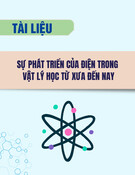
Online reference
•1. Dictionary: (physics) http://tudien.thuvienvatly.com/ ;
(life) https://www.oxfordlearnersdictionaries.com/
(Sharing reading En) https://www.youtube.com/watch?v=dpLVB_4SPQg
•2. Physics:
+Animate: https://faraday.physics.utoronto.ca
+Physical terms: http://www.conservapedia.com/Physical_Science_Terms
+Lecture MIT:
https://www.youtube.com/playlist?list=PLyQSN7X0ro22WeXM2QCKJm2
NP_xHpGV89
+Search: https://www.YOUTUBE.com or https://www.GOOGLE.com/
+... 2

New words –1.1; Physics/ˈfɪzɪks/
1. Concept (n) /ˈkɒnsept/ an idea or a principle that is connected with something
abstract: khái niệm;Ex. Basic concepts of Mechanics...
2. Law (n) /lɔː/ a scientific rule that somebody has stated to explain a natural
process: định luật;Ex.Newton’s second law...
3. Mechanics(n)/məˈkænɪks/ the science of movement and force: cơ học;
4. Mechanic (n) /məˈkænɪk/ a person whose job is repairing machines, especially
the engines of vehicles. Ex. a car/motor mechanic
5. Property (n) /ˈprɒpəti/ a quality or characteristic that something has: tính
chất.Ex. Properties of motion
6. Motion (n) /ˈməʊʃn/ the act or process of moving or the way something moves:
sự chuyển động
7. Particle (n) /ˈpɑːtɪkl/ a very small piece of something: hạt/chất điểm
8. Rigid (adj)/ˈrɪdʒɪd/stiff and difficult to move or bend:cứng,rắn;Ex.Rigid object

New words –1.2
9. Position (n) /pəˈzɪʃn/ the place where somebody/something is located: vị trí
10. Speed (n) /spiːd/ the rate at which somebody/something moves or travels:
tốc độ
11. Velocity (n) /vəˈlɒsəti/ the speed of something in a particular direction: vận
tốc.Ex. Angular velocity, velocity component...
12. Acceleration (n) /əkˌseləˈreɪʃn/ the rate at which the velocity (= speed in a
particular direction) of an object changes: gia tốc
13. Linear (adj) /ˈlɪniə(r)/ able to be represented by a straight line on a graph:
tuyến tính/thẳng
14. Momentum (n) /məˈmentəm/ /məʊˈmentəm/ the quantity of movement of
a moving object, measured as its mass multiplied by its speed: động lượng
15. Work (n) /wɜːk/ the use of force to produce movement: công.Ex. Work done
by gravitational force
16. Principle (n) /ˈprɪnsəpl/ a general or scientific law that explains how
something works or why something happens: nguyên lý, định luật

Syllabus – Đề cương Học phần
1. Title: Physics 1
2. Credits: 3
3. Prerequisites:
Analytics analysis
4. Course Description
This course tends to give students opportunity to explore the basic concepts,
laws and application of Mechanics and Thermodynamics, including:
Properties and laws of motion of particle, rigid body
Relationship among position, velocity and acceleration
Laws of linear momentum, angular momentum and energy
The kinetic theory of gases, thermodynamic quantities
Laws of Thermodynamics


![Bài giảng Vật lý đại cương và sinh lý [mới nhất]](https://cdn.tailieu.vn/images/document/thumbnail/2025/20250804/vijiraiya/135x160/88621754292979.jpg)


















![Bộ câu hỏi lý thuyết Vật lý đại cương 2 [chuẩn nhất/mới nhất]](https://cdn.tailieu.vn/images/document/thumbnail/2025/20251003/kimphuong1001/135x160/74511759476041.jpg)
![Bài giảng Vật lý đại cương Chương 4 Học viện Kỹ thuật mật mã [Chuẩn SEO]](https://cdn.tailieu.vn/images/document/thumbnail/2025/20250925/kimphuong1001/135x160/46461758790667.jpg)




